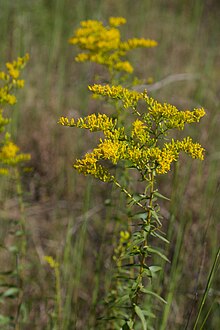Solidago odora
Appearance
| Solidago odora | |
|---|---|

| |
| Scientific classification | |
| Kingdom: | |
| (unranked): | |
| (unranked): | |
| Order: | |
| Family: | |
| Tribe: | |
| Genus: | |
| Species: | S. odora
|
| Binomial name | |
| Solidago odora | |
| Synonyms[1] | |
|
Synonymy
| |
Solidago odora, whose English name is sweet goldenrod, also referred to as anisescented goldenrod[2] or fragrant goldenrod is a North American species of goldenrods within the sunflower family. The plant is native to the United States and Mexico, found in every coastal state from Veracruz to New Hampshire and as far inland as Ohio, Missouri, and Oklahoma.[3] It flowers from July through October.
- Solidago odora ssp. odora - most of species range
- Solidago odora ssp. chapmanii (Gray) Semple - Florida only
As a traditional medicine, Solidago odora had a variety of ethnobotanical uses, especially by the Cherokee.[7]
The leaves, which smell of licorice when crushed, can be made into a tea.[8]
References
- ^ The Plant List, Solidago odora Aiton
- ^ USDA, NRCS (n.d.). "Solidago odora". The PLANTS Database (plants.usda.gov). Greensboro, North Carolina: National Plant Data Team. Retrieved 19 November 2015.
- ^ Biota of North America Program 2014 county distribution map
- ^ Flora of North America, Solidago odora Aiton, 1789. Anise-scented or fragrant or sweet goldenrod
- ^ Integrated Taxonomy Information System ITIS Accessed Sept 28, 2014.
- ^ "Solidago odora". Germplasm Resources Information Network. Agricultural Research Service, United States Department of Agriculture. Retrieved September 28, 2014.
- ^ Hamel, Paul B. and Mary U. Chiltoske (1975). Cherokee Plants and Their Uses —A 400 Year History. Sylva, NC: Herald Publishing Co. p. 36.
- ^ Niering, William A.; Olmstead, Nancy C. (1985) [1979]. The Audubon Society Field Guide to North American Wildflowers, Eastern Region. Knopf. p. 404. ISBN 0-394-50432-1.
